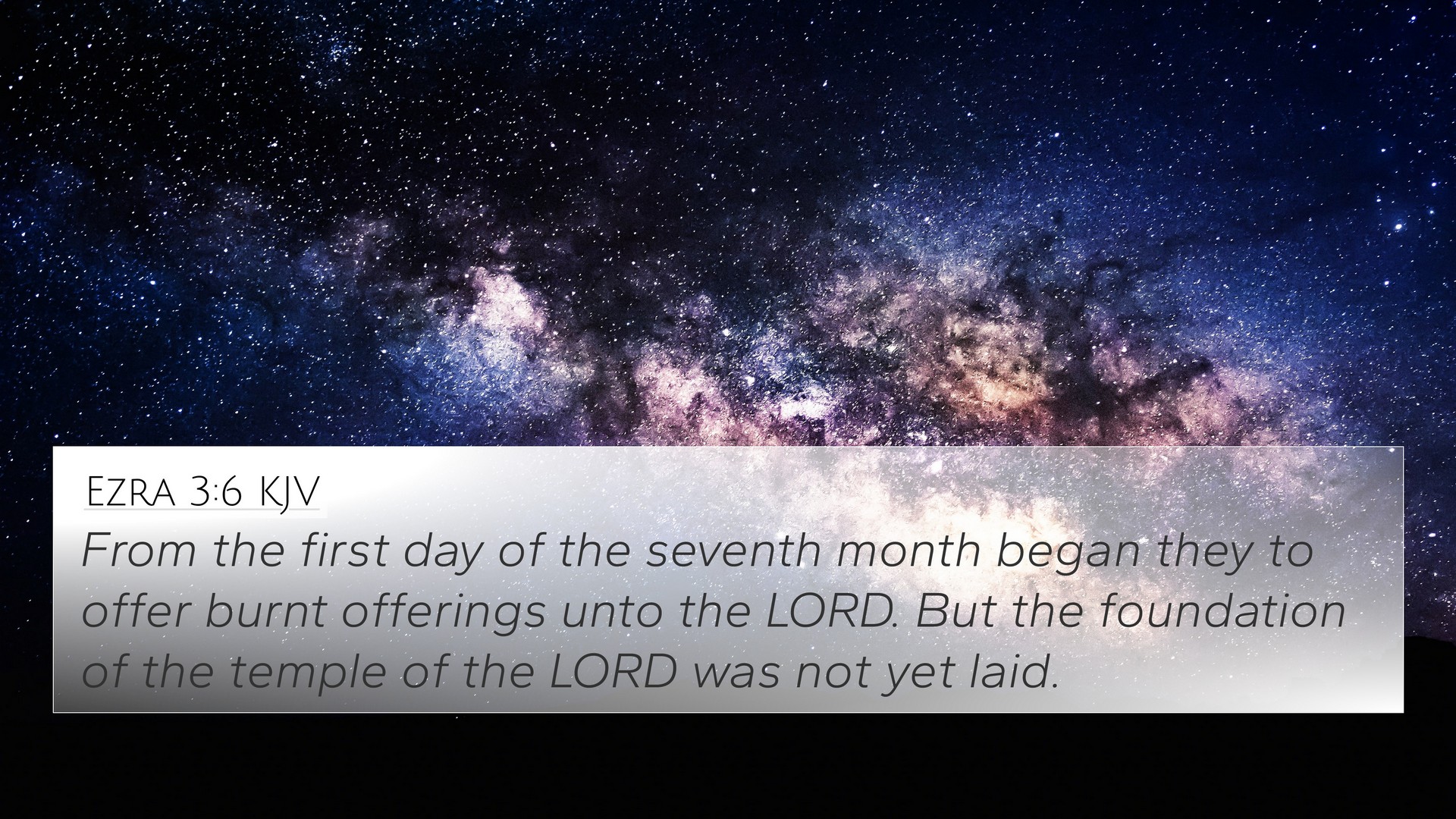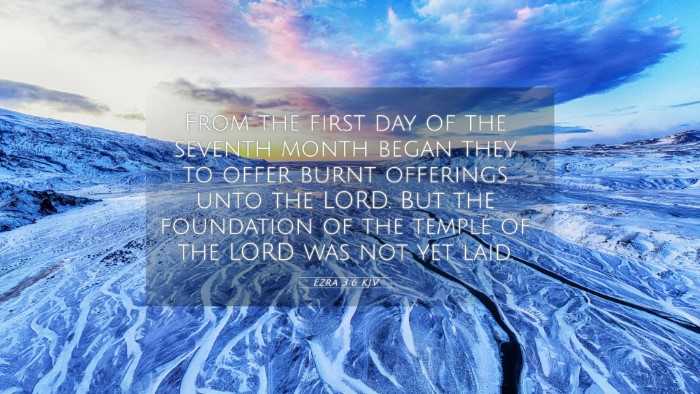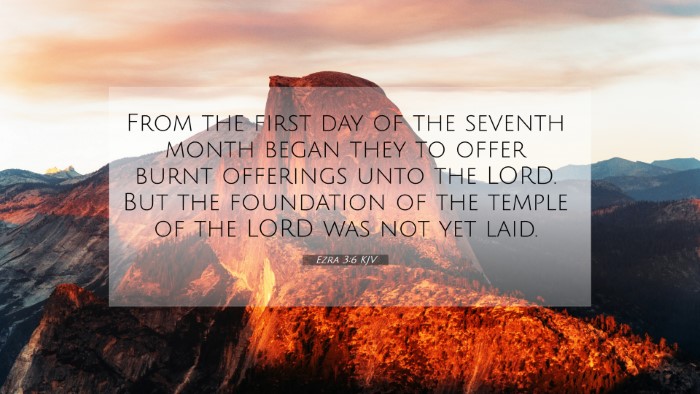Old Testament
Genesis Exodus Leviticus Numbers Deuteronomy Joshua Judges Ruth 1 Samuel 2 Samuel 1 Kings 2 Kings 1 Chronicles 2 Chronicles Ezra Nehemiah Esther Job Psalms Proverbs Ecclesiastes Song of Solomon Isaiah Jeremiah Lamentations Ezekiel Daniel Hosea Joel Amos Obadiah Jonah Micah Nahum Habakkuk Zephaniah Haggai Zechariah MalachiEzra 3:6 Similar Verses
Ezra 3:6 Cross References
From the first day of the seventh month began they to offer burnt offerings unto the LORD. But the foundation of the temple of the LORD was not yet laid.
Uncover the Rich Themes and Topics of This Bible Verse
Listed below are the Bible themes associated with Ezra 3:6. We invite you to explore each theme to gain deeper insights into the Scriptures.
Ezra 3:6 Cross Reference Verses
No cross reference images were found in our system for this Bible passage.
Ezra 3:6 Verse Analysis and Similar Verses
Understanding Ezra 3:6
Ezra 3:6 states, "From the first day of the seventh month they began to offer burnt offerings unto the Lord. But the foundation of the temple of the Lord was not yet laid." This verse occurs in a pivotal moment in Israel's history, emphasizing the connection between worship and the restoration of the temple.
Meaning and Context
This verse captures the enthusiasm of the returned exiles as they begin their process of restoring worship in Jerusalem after the Babylonian captivity. Their first act is to offer burnt offerings, indicative of their desire to re-establish their covenant relationship with God.
Insights from Commentaries
- Matthew Henry: He highlights the importance of the timing, noting that the seventh month is significant in Jewish tradition, where the Feast of Tabernacles occurs, symbolizing God's provision and closeness to His people.
- Albert Barnes: Barnes emphasizes that despite the lack of a temple foundation, the act of worship reflects a pivotal step towards spiritual restoration, signaling their commitment to God even amidst challenges.
- Adam Clarke: Clarke posits that the burnt offerings represent a sincere expression of gratitude and repentance, central to Jewish worship, reinforcing their hope for divine favor and revitalization of their identity as God's people.
Key Themes
Several key themes emerge from this verse:
- Restoration: The returning exiles are focused on restoring their place of worship, signaling their desire to reconnect with God.
- Worship: Offering burnt offerings demonstrates the paramount importance of worship in their community life and spiritual journey.
- Faithfulness: Their actions are rooted in faithfulness despite physical realities that may seem discouraging.
Bible Verse Cross-References
To understand the depth of Ezra 3:6 better, we can look at several cross-references:
- 2 Chronicles 3:1-2: Discusses the beginning of the temple's construction which links to the restoration theme.
- Nehemiah 8:1-12: The reading of the Law signifies the importance of spiritual renewal among the people.
- Haggai 1:8: Encourages the rebuilding of the temple, reinforcing the necessity of re-establishing worship.
- Exodus 20:24: Outlines the laws regarding burnt offerings, providing context on worship practices.
- Psalm 51:17: Reflects the importance of a contrite heart which aligns with the intention behind their offerings.
- 1 Peter 2:5: Illustrates believers as living stones, likening their spiritual sacrifices to the offerings of old.
- Malachi 1:14: Emphasizes the significance of offering acceptable sacrifices, underscoring the importance of pure worship.
Connecting Bible Verses
Understanding how various scriptures interconnect enhances the reading of Ezra 3:6. The following thematic connections stand out:
- Worship through Sacrifice: The relationship between offerings in Ezra and sacrificial themes throughout the law (e.g., Leviticus 1:3-9).
- God’s Faithfulness: The restoration narrative parallels God's promise in Jeremiah 29:10 regarding the return from exile.
- Community Worship: The collective action of offering burnt offerings reflects the unity called for in Acts 2:42.
Practical Applications
For believers today, Ezra 3:6 challenges us to prioritize worship and communal faithfulness, recognizing that spiritual restoration often begins with sincere acts of devotion and a heart desiring to reconnect with God.
Using Cross-Referencing Tools
To delve deeper into Scripture, utilizing tools for Bible cross-referencing can enhance understanding. A bible concordance or a bible cross-reference guide can help identify connections such as:
- Specific themes (e.g., sacrifice, restoration) across both Old and New Testaments.
- Parallels in worship practices from the Pentateuch to the epistles.
- Linking teachings of Jesus in Gospels with prophetic scriptures.
Conclusion
Ezra 3:6 serves as a crucial reminder of the importance of worship, sacrifice, and dedication to building a relationship with God. Through the insights and cross-references provided, we grasp a more profound understanding of the spiritual imperative of worship and community, applicable to current believers.


